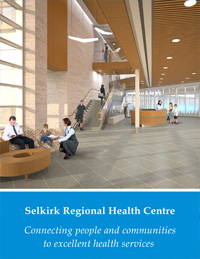Connecting People and Communities to Excellent Health Services
~ By Cheryl Long
It’s not uncommon for residents of Manitoba’s Interlake Region to travel hours for specialized medical procedures. Though the area’s regional hospital in Selkirk provides a full spectrum of health services, more extensive tests such as an MRI require a trip to larger facilities in Winnipeg or Brandon.
That’s why one of Manitoba’s largest capital construction projects in Selkirk is garnering such positive attention throughout the communities served by the Interlake-Eastern Regional Health Authority. In the spring of 2017, residents will be able to step through the doors of the new Selkirk Regional Health Centre.
“The new Selkirk hospital will bring expanded, state-of-the-art health services to families in Selkirk and the surrounding area,” said Manitoba’s Minister of Health Sharon Blady. “Not only will the hospital be nearly twice the size of the old one, it will also include an MRI. Our government is proud to be investing in rural health care, bringing better care closer to home for families across Manitoba.”
The provincially-funded, $111-million construction project broke ground in the spring of 2014 and is approximately 30 percent complete, said Ron Van Denakker, CEO of the Interlake-Eastern RHA. The facility will open in phases, overlapping care provided by the existing Selkirk & District General Hospital until all programs have been moved into the new hospital. Services in the new facility will include surgery, obstetrics, medicine, emergency, diagnostic imaging, rehabilitation, community cancer outreach, dialysis and palliative care, among others.
“From a diagnostics perspective this hospital represents our first opportunity for our own MRI, which is a huge service enhancement for the region,” Van Denakker said. “In terms of physician services, we’ll be in an excellent position to further complement the existing level of expertise within the region.”
Site allows for future expansion
The new facility, spanning just over 180,000 square feet in size, has been situated on a site that will allow for future expansion, Van Denakker said. That could mean attracting additional doctors and specialty services down the road.
“With a facility of this magnitude, the increased number of beds and the additional services that we’re going to be able to provide, we’re going to be recruiting more care providers and expanding our specialty care,” he explained. “Our primary focus is caring for the region’s residents within our expanded scope of services.”
Not only will the new centre provide increased care and services to its population but it will also create jobs. Currently, the Selkirk hospital employs the equivalent of about 245 full-time positions. When the new hospital opens, that number is expected to jump to more than 365. Van Denakker doesn’t foresee any problems in filling those jobs.
“We’re very lucky in the sense that people like to work in Selkirk. It’s a great place to be; it’s a great place to work and live and there’s an awful lot of people that actually live in Selkirk that are working in Winnipeg right now that will have an opportunity to come back home.”
Gary Dandeneau is Director of Capital Planning and Facilities Management for the Interlake-Eastern RHA. The new hospital will place a priority on accessibility and safety for both patients and employees, he explained, by integrating features like video surveillance, enhanced lighting and onsite security staff throughout the property. Careful thought has also been given to emergency situations with the installation of generators that will allow the facility to run on auxiliary power for a minimum of 72 hours.
Technology will be state of the art
There’s a lot of excitement surrounding the new technology being integrated into the hospital’s construction, he said. A state-of-the-art information technology and communications system is just the beginning. A raised floor system in the server room will allow for enhanced cooling and better equipment performance, and wireless communications will run throughout the facility. “It’s going to be a big learning curve but we’re really excited about the amount of technology that is going to go into the new facility,” Dandeneau said.
One of the hospital’s major achievements will be its certification as a silver standard LEED facility. LEED-certified buildings must meet certain prerequisites and adopt green building strategies that promote human and environmental health. It’s “quite difficult to achieve,” Dandeneau pointed out, and it meant that the building’s designers and contractors had to think about sustainability and environmental awareness through all parts of the project.
High-efficiency lighting and water fixtures, enhanced indoor air quality systems, geothermal heat pump technology, a heat recovery system and a certain percentage of recycled building materials are just a few of the features that will put the hospital into the LEED category. The property’s landscaping will also have a “green” feel with bridges stretching over water features, 12 “smart car” auto charging stations and two living roof areas accessed from an exterior terrace. Natural lighting will cascade into the building through a multitude of windows and a central glass courtyard. One of the most unique architectural additions is the use of windows in operating theatres, allowing surgeons to enjoy the benefits of natural lighting. Not only do the sun’s rays increase staff productivity but they allow doctors to see natural skin tones and pigment, which can be beneficial during procedures.
Among the new facility’s innovative features will be a three-bay indoor EMS drive-through — the first to be built in a rural setting in Manitoba, Dandeneau explained. The heated area located adjacent to the emergency room will allow patients to be dropped off in a weather-safe environment and will also offer access to a decontamination area. The larger emergency room will help to lower patient wait times and six isolation rooms will increase both patient and employee safety.
Growing interest from investors, developers
The City of Selkirk has a strong partnership not only with the Interlake-Eastern RHA but with the Province of Manitoba, said Selkirk Mayor Larry Johannson, and the hospital represents a significant investment in the area. A new 80-room Canalta hotel recently opened near the hospital site, representing the chain’s first investment in Manitoba. Other investors and developers are also showing interest in the area, he added.
“We used to be a city that was bypassed for the City of Winnipeg, and that’s just not happening anymore,” Johannson said. “Not only are surrounding areas looking at the City of Selkirk to live, shop and play, but now they’re going to be looking at Selkirk also for their expanded health needs… We’re very excited about it and it’s going to fit well with development plans that we are working on.”
There’s been a high level of community support for the project, he added. “Everybody is excited about the hospital. The framework is going up and you can just see the people excited in town.” That support also extends to private donations from Selkirk residents who have helped to fund the new MRI machine.
Along with the community and business sector, excitement is also being generated among employees of the current Selkirk hospital who are eagerly watching the facility take shape. Dianne Mestdagh is the project’s Equipment and Move Coordinator and is responsible for overseeing the move from the old to new facility. That means planning the purchase of new equipment, coordinating the transfer of staff and equipment without jeopardizing the community’s health care, and ensuring that employees are trained in the new systems that are part of the more modern health-care centre.
“I think staff are very excited, especially now that they see the building going up but they’ve been excited from the very beginning because they’ve been involved in the visioning process and user group planning along the way,” Mestdagh said. “That has kept enthusiasm ramped up over the planning years.”
Majority of patient rooms will be private
Mestdagh can already see how the new hospital will focus on the well-being of patients, families and employees through efficiencies and optimization. Not only will it reflect the region’s history and culture, something that was carefully considered during the planning process, but it also takes into account the changing needs of hospital patients. Approximately 80 percent of the rooms will be private compared to 20 percent in the current Selkirk hospital. The obstetrics unit will offer a labour and delivery recovery post-partum model that allows women to stay in the same room both during and after their baby’s birth. Palliative care rooms will have enhanced outside views, providing increased natural light and physical access to bedridden patients who want to spend time outdoors.
In an effort to provide all residents with equal access to services, the new hospital will contain the region’s first bariatric rooms and specialized equipment. It’s a significant improvement for the region, Dandeneau said.
Looking back, Selkirk’s hospital was built to provide a specific range of services, Van Denakker said, and it has been operating well beyond the original plan. Though the hospital’s employees have put in “an absolutely amazing effort” in the current environment, they’re eager to move into a larger, more technologically advanced facility that will be able to keep up with the demands of the area’s growing population.
“If you look at what’s happening with the City of Selkirk, the city is growing significantly as well so it’s matched very nicely with what’s happening in this local environment, and as we anticipate the city continues to grow, there’s that scalability component as well,” Van Denakker said. “We’re not only planning for today, but we’re planning together with our community partners into the future as well.”









